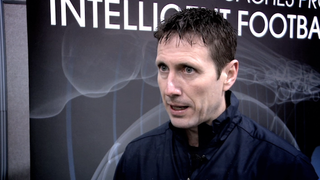Get the best out of your pre-season training
Maximise your gains during pre-season with these tips from Manchester United head of fitness and conditioning, Tony Strudwick

Pre-season is a punishing slog full of hard graft, sweat, blood, tears, dizzy spells and the odd bout of sickness.
For the average Joe they have to find the time for all of this, as well as work and family and friends. Not easy.
And whereas pro footballers have a team of experts guiding them in the right direction, it’s up to an amateur footballer to get fit on their own – until now – because FourFourTwo Performance is here to help.
To ensure you get the best out your limited workout time, FFT spoke to Manchester United's head of fitness and conditioning, Tony Strudwick.
In this video Strudwick outlines what an elite player needs to complete a successful pre-season, providing you tips on how you can optimise your gains.
Good news – it’s not all cross-country runs. Strudwick insists you need to get the footballs out early. Hurray!
But if you do what to shed those love handles in time for the new season you’re going to have to plan, prepare and perspire...
Tony Strudwick was talking at the Science + Football Conference. For more information visit www.scienceandfootball.com.
Also see:
Run faster, boost endurance
Get faster for football
Improve your speed, stamina and strength
Run harder, react quicker
Build endurance and a rock solid core
"The facilities have got to be right, particularly nowadays when clubs go out to far-reaching parts of the world. That's just the global nature of football.
But first and foremost we have to have the right facilities, and the field has to be number one priority because what we can't afford during pre-season is to lose any of our players.
Clearly, if you have injuries during pre-season there is something wrong with the training programme and/or the facilities. That has to be right.
Secondly, you have to get into the football quite quickly. Typically we only get six or seven weeks to prepare and that is not really a long time to prepare for the first day of the season.
Again, we have to utilise the football in small-sided games to achieve multiple outcomes. Use the ball early.
It has to be progressive and it has to be planned. It's not about destroying them in week one, there has to be a gradual increase in work. There has to be a shift in the variables around the small-sided games in the physiology.
Finally, there has to be a gradual involvement in the games-based programme. Many years ago I would have said a typical golfer would have to hit 400 minutes of playing time, but that's not the full picture because we have got to try and ensure that we expose the players to that critical period between 75 and 90 minutes i.e. when they're getting tired before the first game.
Of course, when you have international players coming in at different times you have to micro-manage and that becomes very difficult. The planning has to be spot on."
Get FourFourTwo Newsletter
The best features, fun and footballing quizzes, straight to your inbox every week.

Thank you for reading 5 articles this month* Join now for unlimited access
Enjoy your first month for just £1 / $1 / €1
*Read 5 free articles per month without a subscription

Join now for unlimited access
Try first month for just £1 / $1 / €1
